Electrochemical Lithium Extraction with Gas Flushing of Porous Electrodes
Abstract
:1. Introduction
2. Experiment
2.1. Gas Flushing Electrochemical Lithium Extraction System
2.2. Electrode Fabrication and Characterization
2.3. Electrochemical Characterization
2.4. Lithium Extraction Measurement
2.5. Modeling and Simulation
3. Results and Discussions
3.1. Electrode Characterization
3.2. Water Consumption in Gas-Flushed System
3.3. Simulation in Different Flow Modes
3.4. Lithium Extraction Performance of the System in Simulated Salt Lake Water
4. Conclusions
Supplementary Materials
Author Contributions
Funding
Data Availability Statement
Conflicts of Interest
References
- Alessia, A.; Alessandro, B.; Maria, V.-G.; Carlos, V.-A.; Francesca, B. Challenges for sustainable lithium supply: A critical review. J. Clean. Prod. 2021, 300, 126954. [Google Scholar] [CrossRef]
- Martin, G.; Rentsch, L.; Höck, M.; Bertau, M. Lithium market research—global supply, future demand and price development. Energy Storage Mater. 2017, 6, 171–179. [Google Scholar] [CrossRef]
- Choubey, P.K.; Kim, M.-S.; Srivastava, R.R.; Lee, J.-C.; Lee, J.-Y. Advance review on the exploitation of the prominent energy-storage element: Lithium. Part I: From mineral and brine resources. Miner. Eng. 2016, 89, 119–137. [Google Scholar] [CrossRef]
- Gao, T.; Fan, N.; Dai, T. Lithium extraction from hard rock lithium ores: Technology, resources, environment and cost. China Geol. 2022, 6, 137–153. [Google Scholar] [CrossRef]
- Kesler, S.E.; Gruber, P.W.; Medina, P.A.; Keoleian, G.A.; Everson, M.P.; Wallington, T.J. Global lithium resources: Relative importance of pegmatite, brine and other deposits. Ore Geol. Rev. 2012, 48, 55–69. [Google Scholar] [CrossRef]
- Zhang, Y.; Hu, Y.; Wang, L.; Sun, W. Systematic review of lithium extraction from salt-lake brines via precipitation approaches. Miner. Eng. 2019, 139, 105868. [Google Scholar] [CrossRef]
- Grosjean, C.; Miranda, P.H.; Perrin, M.; Poggi, P. Assessment of world lithium resources and consequences of their geographic distribution on the expected development of the electric vehicle industry. Renew. Sustain. Energy Rev. 2012, 16, 1735–1744. [Google Scholar] [CrossRef]
- Kundu, T.; Rath, S.S.; Das, S.K.; Parhi, P.K.; Angadi, S.I. Recovery of lithium from spodumene-bearing pegmatites: A comprehensive review on geological reserves, beneficiation, and extraction. Powder Technol. 2023, 415, 118142. [Google Scholar] [CrossRef]
- Liu, W.; Agusdinata, D.B. Interdependencies of lithium mining and communities sustainability in Salar de Atacama, Chile. J. Clean. Prod. 2020, 260, 120838. [Google Scholar] [CrossRef]
- Zhang, J.; Cheng, Z.; Qin, X.; Gao, X.; Wang, M.; Xiang, X. Recent advances in lithium extraction from salt lake brine using coupled and tandem technologies. Desalination 2023, 547, 116225. [Google Scholar] [CrossRef]
- Toba, A.-L.; Nguyen, R.T.; Cole, C.; Neupane, G.; Paranthaman, M.P. U.S. lithium resources from geothermal and extraction feasibility. Resour. Conserv. Recycl. 2021, 169, 105514. [Google Scholar] [CrossRef]
- Wang, J.; Yue, X.; Wang, P.; Yu, T.; Du, X.; Hao, X.; Abudula, A.; Guan, G. Electrochemical technologies for lithium recovery from liquid resources: A review. Renew. Sustain. Energy Rev. 2022, 154, 111813. [Google Scholar] [CrossRef]
- Xiong, Y.; Zhou, J.; Lu, P.; Yin, J.; Wang, Y.; Fan, Z. Electrochemical lithium extraction from aqueous sources. Matter 2022, 5, 1760–1791. [Google Scholar] [CrossRef]
- Zhang, Y.; Sun, W.; Xu, R.; Wang, L.; Tang, H. Lithium extraction from water lithium resources through green electrochemical-battery approaches: A comprehensive review. J. Clean. Prod. 2021, 285, 124905. [Google Scholar] [CrossRef]
- Kim, S.; Lee, J.; Kang, J.S.; Jo, K.; Kim, S.; Sung, Y.E.; Yoon, J. Lithium recovery from brine using a lambda-MnO2/activated carbon hybrid supercapacitor system. Chemosphere 2015, 125, 50–56. [Google Scholar] [CrossRef]
- Kim, S.; Lee, J.; Kim, S.; Kim, S.; Yoon, J. Electrochemical Lithium Recovery with a LiMn2O4-Zinc Battery System using Zinc as a Negative Electrode. Energy Technol. 2018, 6, 340–344. [Google Scholar] [CrossRef]
- Luo, G.; Li, X.; Chen, L.; Zhang, Y.; Gu, J.; Chao, Y.; Zhu, W.; Liu, Z.; Xu, C. Island-like CeO2 decorated LiMn2O4: Surface modification enhancing electrochemical lithium extraction and cycle performance. Chem. Eng. J. 2023, 455, 140928. [Google Scholar] [CrossRef]
- Zhao, M.-Y.; Ji, Z.-Y.; Zhang, Y.-G.; Guo, Z.-Y.; Zhao, Y.-Y.; Liu, J.; Yuan, J.-S. Study on lithium extraction from brines based on LiMn2O4/Li1−xMn2O4 by electrochemical method. Electrochim. Acta 2017, 252, 350–361. [Google Scholar] [CrossRef]
- Zhao, X.; Yang, S.; Hou, Y.; Gao, H.; Wang, Y.; Gribble, D.A.; Pol, V.G. Recent progress on key materials and technical approaches for electrochemical lithium extraction processes. Desalination 2023, 546, 116189. [Google Scholar] [CrossRef]
- Lawagon, C.P.; Nisola, G.M.; Cuevas, R.A.I.; Kim, H.; Lee, S.-P.; Chung, W.-J. Li1−xNi0.33Co1/3Mn1/3O2/Ag for electrochemical lithium recovery from brine. Chem. Eng. J. 2018, 348, 1000–1011. [Google Scholar] [CrossRef]
- Lawagon, C.P.; Nisola, G.M.; Cuevas, R.A.I.; Torrejos, R.E.C.; Kim, H.; Lee, S.-P.; Chung, W.-J. Li1−xNi0.5Mn1.5O4/Ag for electrochemical lithium recovery from brine and its optimized performance via response surface methodology. Sep. Purif. Technol. 2019, 212, 416–426. [Google Scholar] [CrossRef]
- Luo, G.; Zhu, L.; Li, X.; Zhou, G.; Sun, J.; Chen, L.; Chao, Y.; Jiang, L.; Zhu, W. Electrochemical lithium ions pump for lithium recovery from brine by using a surface stability Al2O3–ZrO2 coated LiMn2O4 electrode. J. Energy Chem. 2022, 69, 244–252. [Google Scholar] [CrossRef]
- Wang, Y.; Zhang, J.; Cheng, Z.; Xiang, X. Hydrophilic Modification Using Polydopamine on Core–Shell Li1.6Mn1.6O4@Carbon Electrodes for Lithium Extraction from Lake Brine. ACS Sustain. Chem. Eng. 2022, 10, 8970–8979. [Google Scholar] [CrossRef]
- Xiong, J.; He, L.; Zhao, Z. Lithium extraction from high-sodium raw brine with Li0.3FePO4 electrode. Desalination 2022, 535, 115822. [Google Scholar] [CrossRef]
- Guo, Z.-Y.; Ji, Z.-Y.; Wang, J.; Guo, X.-F.; Liang, J.-S. Electrochemical lithium extraction based on “rocking-chair” electrode system with high energy-efficient: The driving mode of constant current-constant voltage. Desalination 2022, 533, 115767. [Google Scholar] [CrossRef]
- Zhao, X.; Zheng, L.; Hou, Y.; Wang, Y.; Zhu, L. Pulsed electric field controlled lithium extraction process by LMO/MXene composite electrode from brines. Chem. Eng. J. 2022, 450, 138454. [Google Scholar] [CrossRef]
- Hong, Z.; Zhu, Q.; Liu, Y.; Wang, S.; Wu, J.; Jiang, H.; Hu, X.; Liu, K. Dependence of concentration polarization on discharge profile in electrochemical lithium extraction. Desalination 2022, 527, 115567. [Google Scholar] [CrossRef]
- Zhao, X.; Li, G.; Feng, M.; Wang, Y. Semi-continuous electrochemical extraction of lithium from brine using CF-NMMO/AC asymmetric hybrid capacitors. Electrochim. Acta 2020, 331, 135285. [Google Scholar] [CrossRef]
- Kim, N.; Su, X.; Kim, C. Electrochemical lithium recovery system through the simultaneous lithium enrichment via sustainable redox reaction. Chem. Eng. J. 2021, 420, 127715. [Google Scholar] [CrossRef]
- Palagonia, M.S.; Brogioli, D.; La Mantia, F. Lithium recovery from diluted brine by means of electrochemical ion exchange in a flow-through-electrodes cell. Desalination 2020, 475, 114192. [Google Scholar] [CrossRef]
- Santos, C.; La Mantia, F. Recent advances in reactor design and control for lithium recovery by means of electrochemical ion pumping. Curr. Opin. Electrochem. 2022, 35, 101089. [Google Scholar] [CrossRef]
- Romero, V.C.E.; Llano, K.; Calvo, E.J. Electrochemical extraction of lithium by ion insertion from natural brine using a flow-by reactor: Possibilities and limitations. Electrochem. Commun. 2021, 125, 106980. [Google Scholar] [CrossRef]
- Palagonia, M.S.; Brogioli, D.; Mantia, F.L. Influence of Hydrodynamics on the Lithium Recovery Efficiency in an Electrochemical Ion Pumping Separation Process. J. Electrochem. Soc. 2017, 164, E586–E595. [Google Scholar] [CrossRef]
- Liu, Y.; Zhu, Q.; Yu, X.; Yang, P.; Liu, K. Modeling and performance predictions of electrochemical lithium extraction: Impact of leakage current. Desalination 2023, 550, 116395. [Google Scholar] [CrossRef]
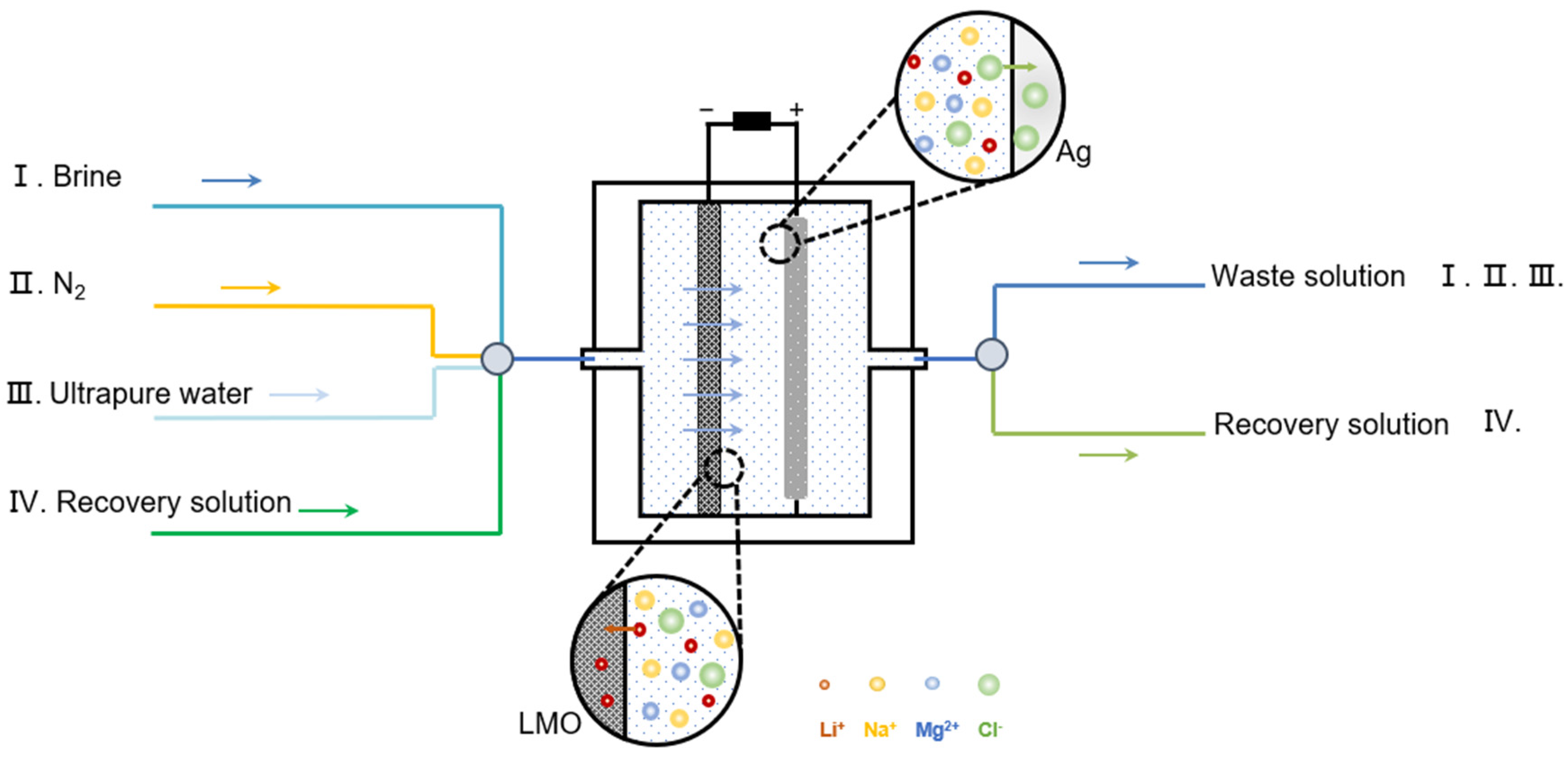
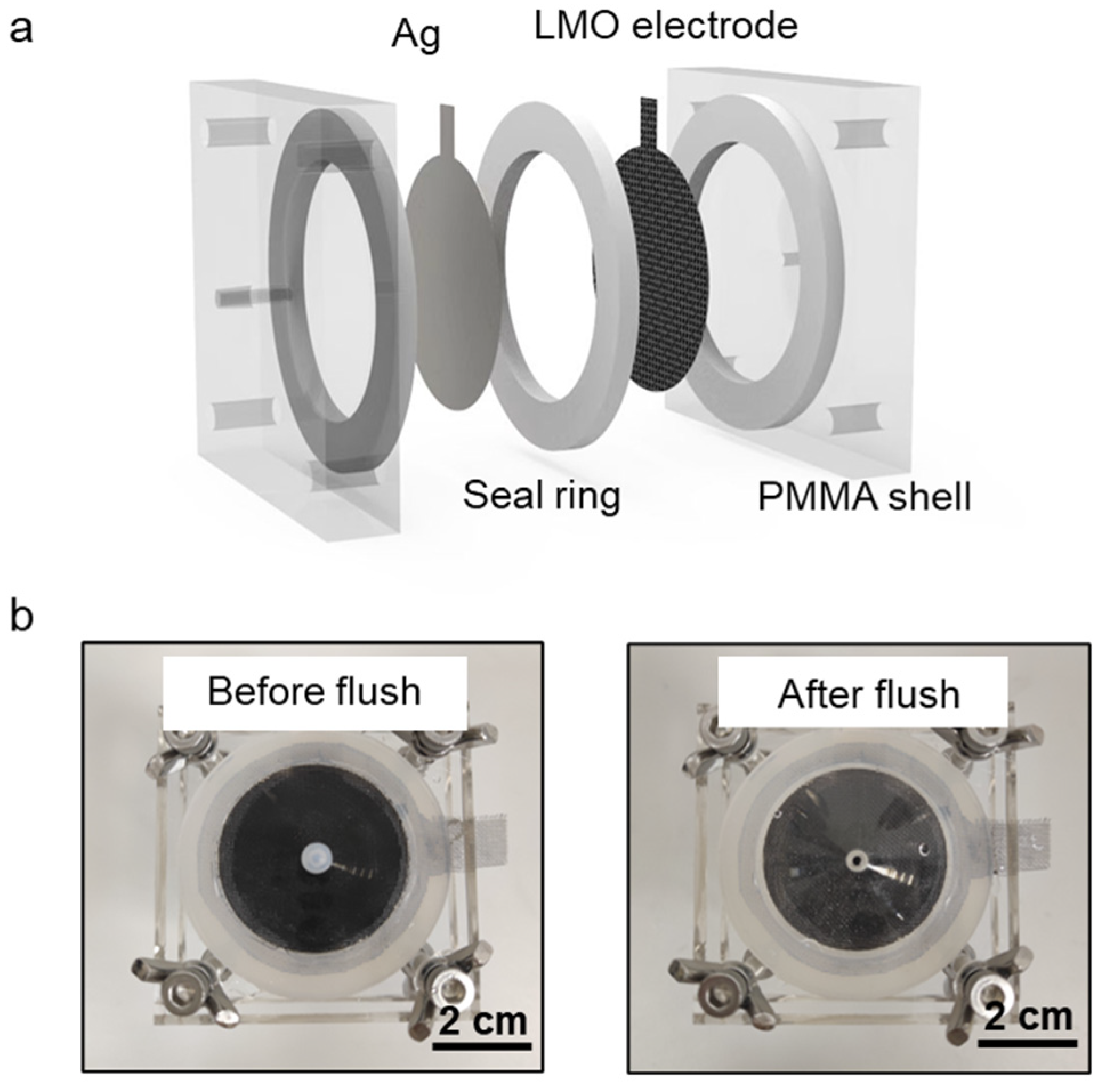

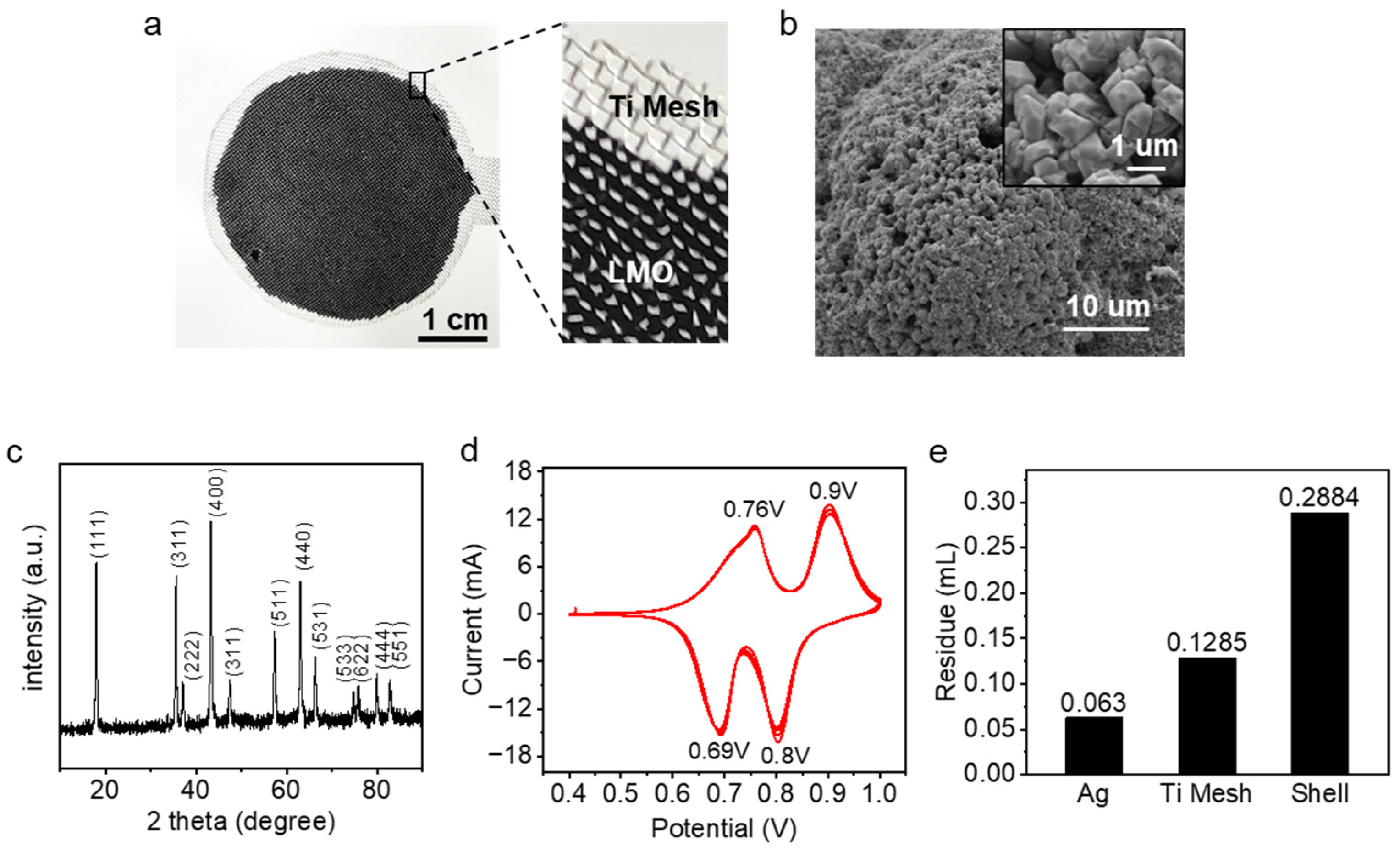
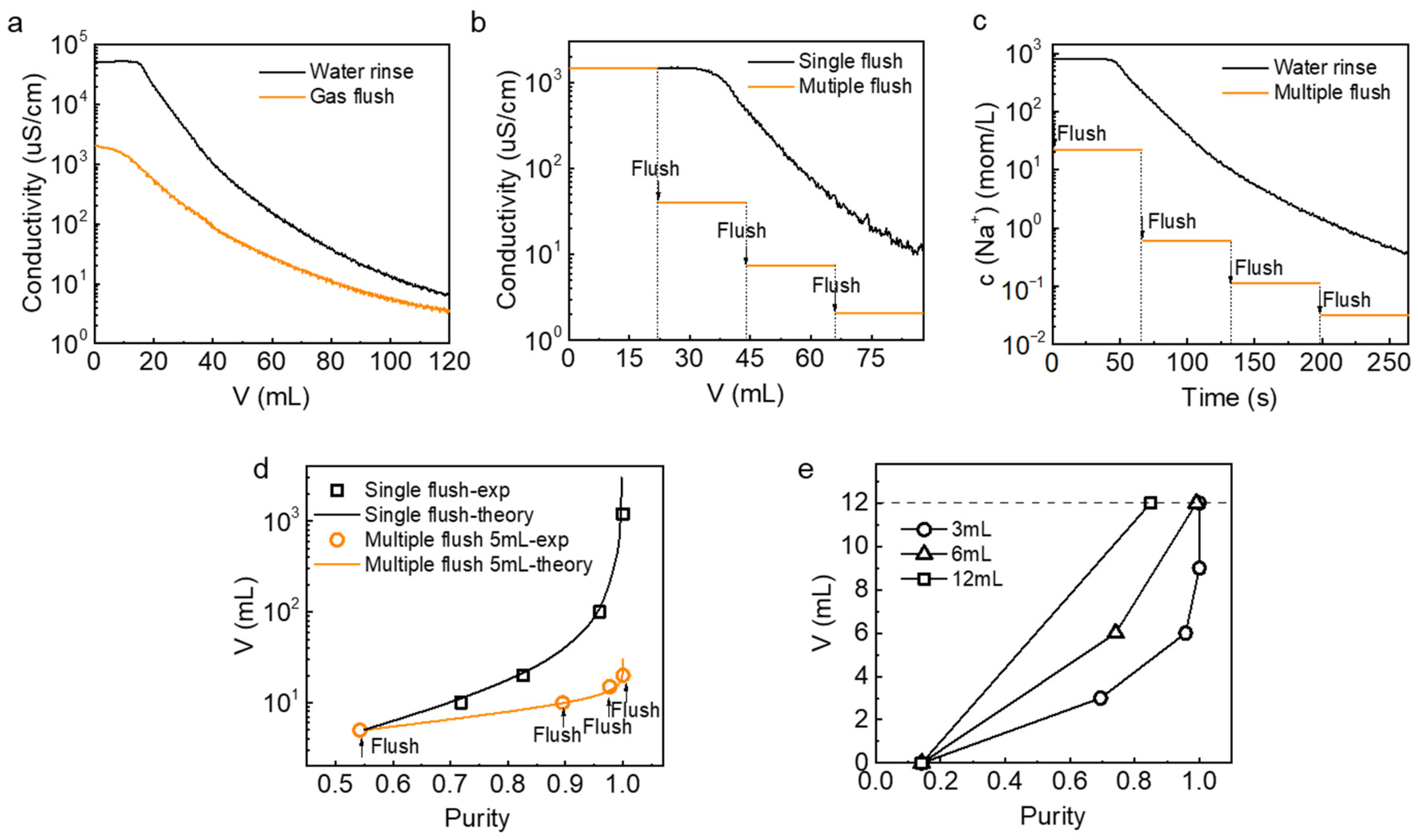
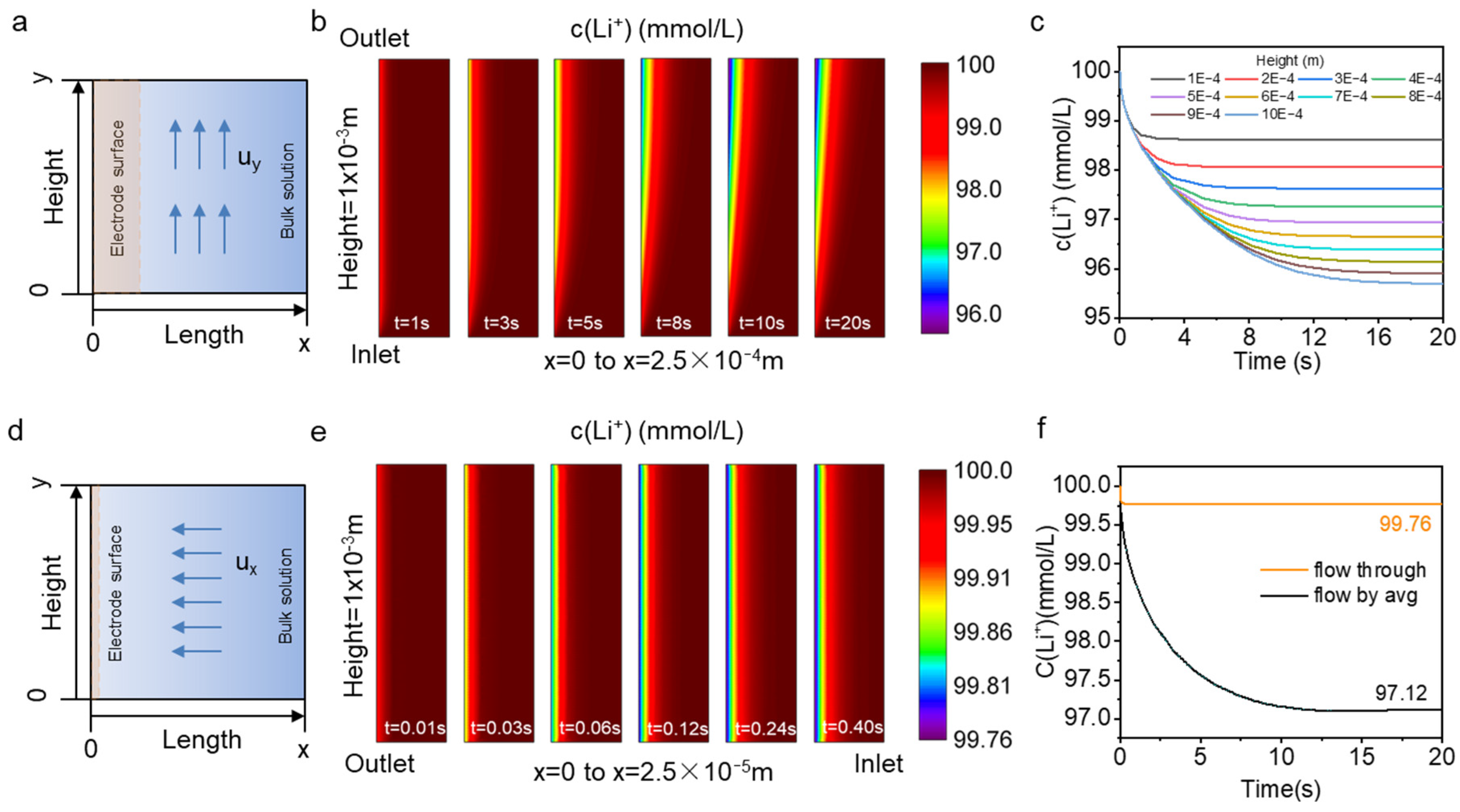
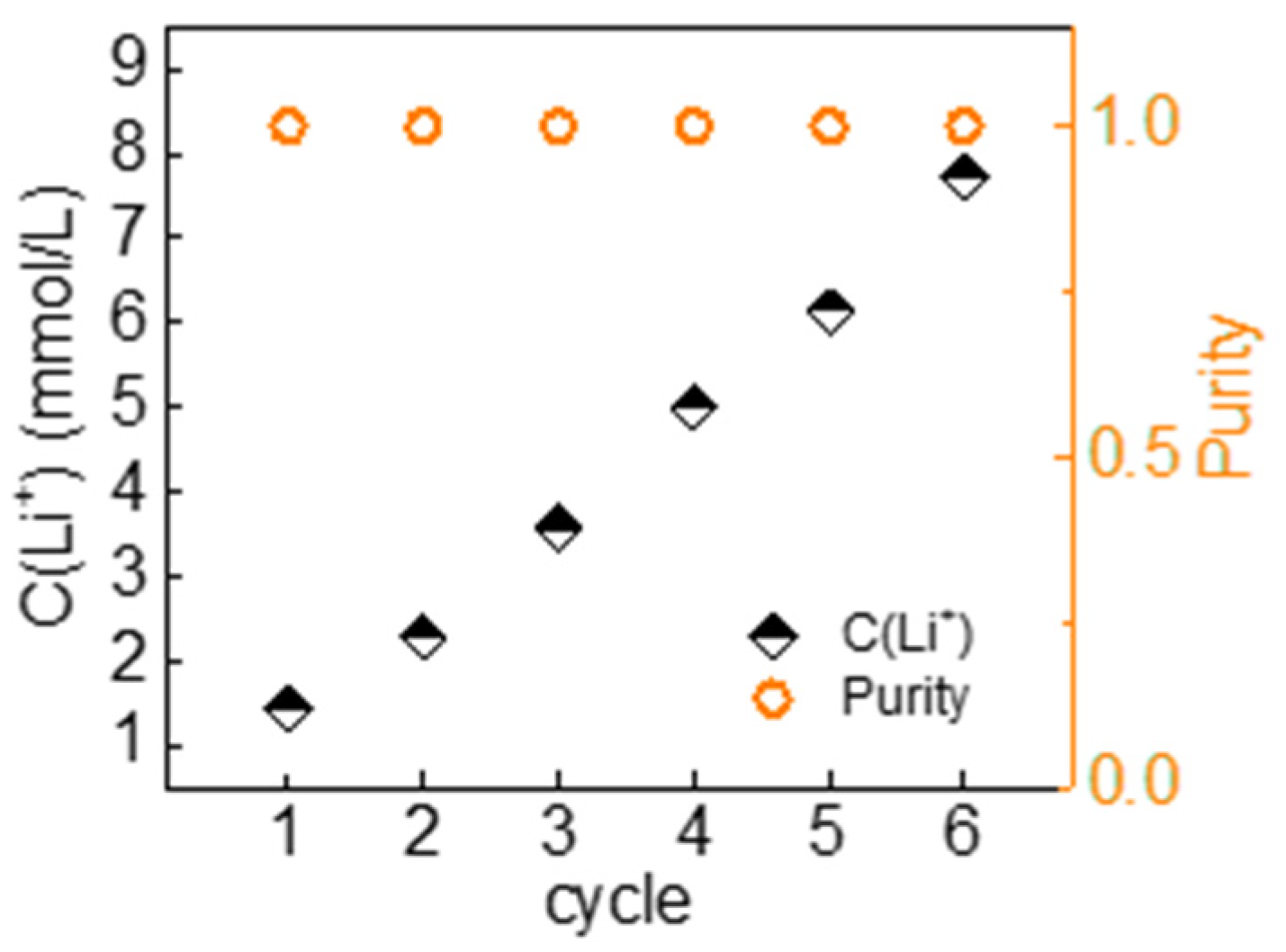
| Parameter | Description | Value |
|---|---|---|
| L | Thickness of depletion region [m] | 1 × 10−3 |
| H | Length of electrode surface [m] | 1 × 10−3 |
| λS | Thickness of stern layer [m] | 3 × 10−10 |
| DLi+ | Diffusion coefficient of Li+ [m2 s−1] | 9.9 × 10−10 |
| DNa+ | Diffusion coefficient of Na+ [m2 s−1] | 13.4 × 10−10 |
| DMg2+ | Diffusion coefficient of Mg2+ [m2 s−1] | 7.5 × 10−10 |
| DCl− | Diffusion coefficient of Cl− [m2 s−1] | 1.98 × 10−9 |
| cLi+,0 | Initial concentration of Li+ in electrolyte [mol m−3] | 100 |
| cNa+,0 | Initial concentration of Na+ in electrolyte [mol m−3] | 100 |
| cMg2+,0 | Initial concentration of Mg2+ in electrolyte [mol m−3] | 100 |
| cCl−,0 | Initial concentration of Cl− in electrolyte [mol m−3] | 400 |
| ε | Permittivity of the electrolyte [F m−1] | 78.5 |
| T | Absolute temperature [K] | 298.15 |
| F | Faraday constant [C mol−1] | 96,484 |
| R | Molar gas constant [J mol−1 K−1] | 8.314 |
| Cycle | Production (mmol⋅g−1⋅h−1) | Energy Consumption (kWh⋅kg−1) |
|---|---|---|
| 1 | 1.714 | 0.476 |
| 2 | 1.029 | 0.677 |
| 3 | 1.543 | 0.600 |
| 4 | 1.714 | 0.904 |
| 5 | 1.371 | 0.955 |
| 6 | 1.886 | 0.781 |
| Average | 1.543 | 0.732 |
Disclaimer/Publisher’s Note: The statements, opinions and data contained in all publications are solely those of the individual author(s) and contributor(s) and not of MDPI and/or the editor(s). MDPI and/or the editor(s) disclaim responsibility for any injury to people or property resulting from any ideas, methods, instructions or products referred to in the content. |
© 2023 by the authors. Licensee MDPI, Basel, Switzerland. This article is an open access article distributed under the terms and conditions of the Creative Commons Attribution (CC BY) license (https://creativecommons.org/licenses/by/4.0/).
Share and Cite
Wang, S.; Yu, X.; Hu, X. Electrochemical Lithium Extraction with Gas Flushing of Porous Electrodes. Nanomaterials 2023, 13, 1471. https://doi.org/10.3390/nano13091471
Wang S, Yu X, Hu X. Electrochemical Lithium Extraction with Gas Flushing of Porous Electrodes. Nanomaterials. 2023; 13(9):1471. https://doi.org/10.3390/nano13091471
Chicago/Turabian StyleWang, Shengyao, Xuyu Yu, and Xuejiao Hu. 2023. "Electrochemical Lithium Extraction with Gas Flushing of Porous Electrodes" Nanomaterials 13, no. 9: 1471. https://doi.org/10.3390/nano13091471
APA StyleWang, S., Yu, X., & Hu, X. (2023). Electrochemical Lithium Extraction with Gas Flushing of Porous Electrodes. Nanomaterials, 13(9), 1471. https://doi.org/10.3390/nano13091471






